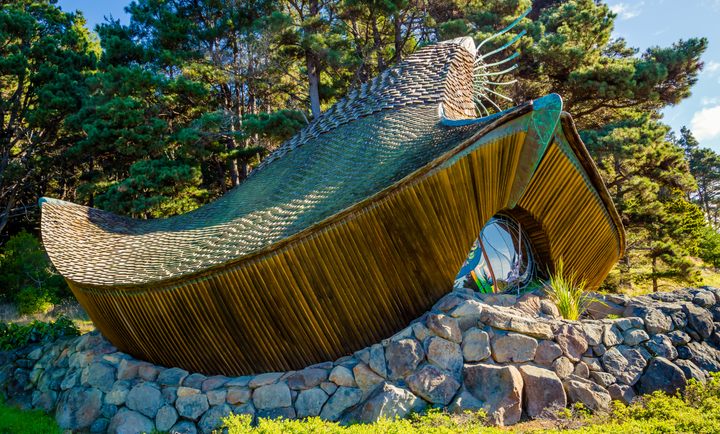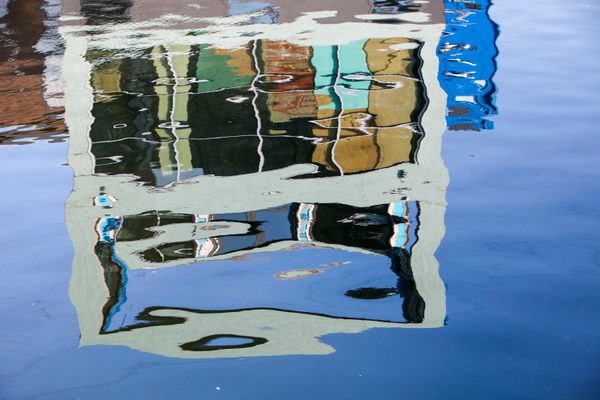
10 Mind-Blowing Structures You Have to See for Yourself
Set your sights on the world’s most fascinating human-made wonders.
In northern Finland, a community of artists spends five weeks each winter building an ephemeral ice castle that will melt in the spring. In Belgium, a bed-and-breakfast offers a room shaped like a Trojan horse, drawbridge and all. And in Canada, you can walk inside a massive pinhole camera. These structures are feats of architecture, design, and imagination. Below are some of the most striking human-made wonders we know of that you may not, from hotels to bridges made from tree roots.

Montaña Mágica Lodge, Chile
This hotel is part-waterfall, part-volcano, part-treehouse, and part–land art project. It looks as though it was dug into a natural stone spire, but the Montaña Mágica Lodge was built by human hands, with locally sourced lumber and stone. Water pours down the sides of the structure between the guest windows, running under rich layers of jungle foliage growing on the exterior. It can only be accessed via rope bridge, but the journey is rewarded with hot tubs carved out of enormous tree trunks that overlook the Huilo-Huilo Biological Reserve.
Sea Ranch Chapel, California
Inspired by the waves of the nearby Pacific and the natural landscape of the coast, this spiritual outpost makes visitors feel like they’ve fallen into a fairy tale. Built in 1985 from local copper and redwood by local carpenters and builders, the nondenominational chapel was modeled on the form of a murex snail shell, though others have compared it to a mushroom or a conquistador’s helmet. Robert and Betty Buffum, both residents of Sea Ranch, donated the chapel to the community in memory of Kirk Ditzler, a local Navy pilot and artist, hoping it could be a refuge for all.

Baldwin Street Houses, New Zealand
Thanks to some blunt city planning, Dunedin residential Baldwin Street has become known as one of the world’s steepest roads. Seen from a certain angle, its houses seem to slide down the hill: Their axes are completely off balance with the street’s pitch. Baldwin Street seems to take a good deal of pride in its reputation. Each year, multiple charity events are held on the street, including a fun run to promote fitness, where people go up and then down the shockingly laborious thousand-some feet, and an even weirder event in which spherical, red-coated chocolate candies bounce downhill in a distance race.
Waseda El Dorado, Japan
Right smack in the University district of Waseda stands the eccentric El Dorado building, one of the most notable architectural oddities in Tokyo. Also known as Rhythms of Vision, it’s known for an exquisite, avant-garde, and Gaudí-esque design, a style typical of its creator, Japanese architect Von Jour Caux. Built in 1983, the entire building is a work of art, its exterior adorned with an array of decorations that border on bizarre. Inside is an outlandish world of abstract murals and colorful stained glass, housed in what looks like a long-forgotten Gothic cathedral.

The Big Pineapple, South Africa
Standing just under 56 feet tall, the Big Pineapple outside of Bathurst is the world’s largest pineapple building. The surrounding area is mostly agricultural land, known for its production of the sweet fruit, so locals naturally decided to honor the prosperity it brought by erecting this massive building. The Big Pineapple was built in the 1980s out of metal and fiberglass, and the inside contains a museum dedicated to—well, what else—and offers a variety of pineapple products for sale.
Kemi Snow Castle, Finland
Each winter, the town of Kemi in Finnish Lapland builds a massive castle from snow, and each spring it melts into muddy sludge. The castle complex takes five weeks to build: Twelve-foot-tall castle walls encompass a hotel, art gallery, and chapel, where people come from across the globe to get married. Each portion is lit with colorful lights that add splendor to the ice walls, and a bit of brightness to dark Arctic winters.

The Root Bridges of Cherrapunji, India
Northeastern India, within sight of the border with Bangladesh, is one of the wettest places on Earth. The southern Khasi and Jaintia Hills are humid and warm, crisscrossed by swift-flowing rivers and mountain streams. On the slopes of these hills, a species of Indian rubber tree with an incredibly strong root system thrives. The War-Khasis and War-Jaintias, two closely related tribes in the region, have long used the tree’s powerful roots as bridges, by finding strategic ways to grow the roots across local rivers. These root bridges have been known to grow as long as 170 feet, and soar 80 feet above the streams they cross.
La Balade Des Gnomes, Belgium
An architect with a dream created this unique bed-and-breakfast in Heyd. Its 10 rooms each have a different fantasy theme: the Moon, subterranean trolls, sailboats, a forest cabin. The most famous is a standalone two-story building shaped like a Trojan Horse, with its own motorized drawbridge entrance. The horse’s head is a room that can be moved around by levers inside. The whole building gives the feeling of being within a mythical, medieval, wooden, post-apocalyptic mobile home.

Casa Salderini, Italy
Also known as the Whale House or the Dinosaur House, Casa Salderini was designed by Vittorio Giorgini, a Florentine architect interested in the relationship between architecture and nature. Built in 1962, it was the first building in the world based on an iso-elastic membrane made of concrete and wire netting. Even the floor of the house is wavy, but despite the organic curves, the building is quite stable.
Camera Obscura, Canada
In the small town of Cheverie, Nova Scotia, you will find an odd-looking brick structure near a salt marsh trail. This is the Camera Obscura, which was built in 2012 by architecture students from Dalhousie University, based on late-19th-century camera technology. In the dark interior, you will see closed doors. This area is officially the large-scale pinhole camera, which you can enter, and close the doors behind you for the full effect. When you look up, you’ll see a reflected and upside-down view of the cliffs across the water, and on the concrete floor below you is a real-time projection.





















Follow us on Twitter to get the latest on the world's hidden wonders.
Like us on Facebook to get the latest on the world's hidden wonders.
Follow us on Twitter Like us on Facebook